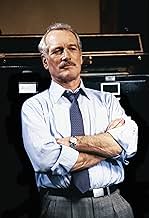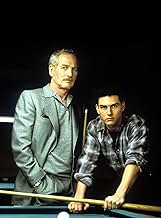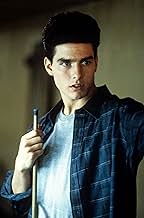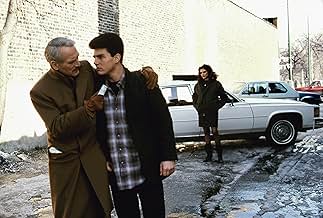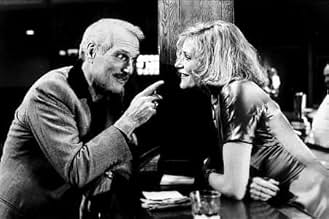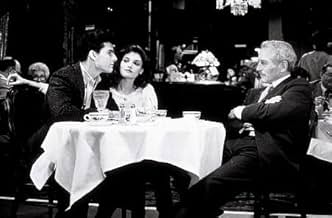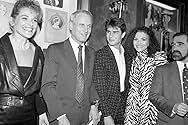Eddie Felson, il vecchio campione di biliardo torna nel mondo del tappeto verde per associarsi col giovane prodigio Vincent. Eddie è il manager, Vincent il giocatore.Eddie Felson, il vecchio campione di biliardo torna nel mondo del tappeto verde per associarsi col giovane prodigio Vincent. Eddie è il manager, Vincent il giocatore.Eddie Felson, il vecchio campione di biliardo torna nel mondo del tappeto verde per associarsi col giovane prodigio Vincent. Eddie è il manager, Vincent il giocatore.
- Regia
- Sceneggiatura
- Star
- Vincitore di 1 Oscar
- 3 vittorie e 10 candidature totali
Recensioni in evidenza
"The Color Of Money" continues the story of pool player/hustler 'Fast Eddie' Felson (Paul Newman). He's 25 years old, and 25 years wiser as he's spent that time watching pool hustles and schemes and selling wine after his 'early' retirement from pool playing in the original.
But now he's got a new excitement and energy to the game, as he meets Vincent (Tom Cruise), a young, cocky but talented fresh player who's not well known around the low-level pool rooms Eddie has been frequenting. Eddie and Vincent's girlfriend, Carmen (Mary Elizabeth Mastrantonio) see Vincent as a cash cow. Indeed, everybody uses everyone, and we're never quite sure the relationship between the three. That's the beauty of it.
Scorsese's never been more refined yet quietly flashy, dealing with a traditional 'old' Hollywood tale of a mentor and protege as small time hustlers playing each other and getting played. The film is an underrated gem, truly downplayed in Scorsese's overall filmography.
Definitely recommended.
But now he's got a new excitement and energy to the game, as he meets Vincent (Tom Cruise), a young, cocky but talented fresh player who's not well known around the low-level pool rooms Eddie has been frequenting. Eddie and Vincent's girlfriend, Carmen (Mary Elizabeth Mastrantonio) see Vincent as a cash cow. Indeed, everybody uses everyone, and we're never quite sure the relationship between the three. That's the beauty of it.
Scorsese's never been more refined yet quietly flashy, dealing with a traditional 'old' Hollywood tale of a mentor and protege as small time hustlers playing each other and getting played. The film is an underrated gem, truly downplayed in Scorsese's overall filmography.
Definitely recommended.
There are two possible reviews that could be written about this film; two kinds, that is. One kind comes from somebody who's never seen "The Hustler" (1961), who's main character, Fast Eddie Felson, played by Paul Newman, is here reprised and replayed by the same actor, after 25 years has gone by, in a new script. I'm curious to read a review of this kind. I've seen "The Hustler" and rank it very high on my list of great films. So I can only write a review of this other kind. If you know the story from "Hustler" (and love it), how can you not be interested in what happens to Fast Eddie later in life? I was immediately aware of the extension of ideas (money, excellence, honor, pride, and deceit) from "The Hustler" and curious to see where Scorsese would take them. I think he's true to the time period: the clothing (and Vince's hair!), the music (very 80's), and the shift of values (as compared to 60s; e.g. cocaine replacing alcohol). Fast Eddie is also true to his age (and former excellence as a hustler). It feels like he's inherited a bit of Bert (from "The Hustler), a festering bitterness and pride, which reemerges when he meets Vince. I actually liked Tom Cruise as the innocent Vince and thought he played him perfectly. I winced to see him lose that innocence, which is probably what the film means to do. Mastroantonio is also pretty fabulous and yet no where near as cognizant and complex as Piper Laurie's character in "The Hustler." In that respect, this film is not as "cool" as "The Hustler." To credit Scorsese, he avoids trying to make a film as cool or similar in look to the original. Also, this movie does not attempt to gloss over Fast Eddie's faults (indeed it focuses on them intensely), and it doesn't mean to have him come to some redemption (although he does return to some of his former glory as a pool player). For me, my interest in the development of the story hinges upon my knowledge of what happened in "The Hustler." There was no way I could separate this fact from my judgement of the movie. I was disappointed only in so far that I wasn't watching "The Hustler" instead; and that's unfair to this movie. So, I don't know how this movie stands on its own. Try to imagine a movie about Rick, reprised by Bogart, from "Casablanca" 25 years later, called "The Taste of Defeat" when he's living in Paris, bloated from drink and lamenting the loss of swing jazz and, alas, his only love,Ilsa, etc etc.
People misunderstood "The Color of Money," I think. There are a few things to keep in mind:
1) This was a Martin Scorsese film. Scorsese was fresh off "Taxi Driver," "Raging Bull," and other such successes from less than a decade before. People were expecting a lot.
2) It starred Paul Newman, returning to his character from "The Hustler," in a sequel that was twenty-five years in the making. That's longer than the wait for the "Phantom Menace" prequel.
Perhaps for those two (very strong) reasons alone, when "The Color of Money" opened in 1986, the critics and audiences didn't think much of it. It garnered decent praise from both areas but most critics seemed to agree: it didn't hold a candle to "The Hustler," and anyone other than Scorsese could have easily made the same picture.
After 19 years, I disagree. I think "The Color of Money" is not only an intelligent and amusing character piece, but an excellent continuation of a character we haven't seen for 25 years.
First of all, Scorsese's direction isn't his best, but it's still very good. And he's definitely got the same elements going on as "After Hours" from a few years before -- his cinematography is identical and the dark colors and grainy '80s vibe are present in every frame. Likewise he's using the quick-cuts and zooms and iconic panning shots that he's known for. The thing is, Scorsese's styles just changed a bit during the 1980s (they even carried on into "GoodFellas" -- the night-time shots carry the same foreboding look as "After Hours" and "Color of Money"). I think now, looking back, since we've seen more of Scorsese's films, it's easier to notice that this is indeed a Martin Scorsese film. A man who is constantly changing his directorial approach. (Just look at "The Aviator" for goodness sake!) Newman deserved the Oscar more for "The Hustler," of course, but for what it's worth, Fast Eddie Felson's evolution is handled with care in the script and it's very entertaining (for anyone who's seen the original) to note the change in his behavior. It's also interesting to see the new cocky pool hustler, Vince (Tom Cruise), filling in the shoes of Eddie from a few decades before.
If "The Hustler" was a great insight into the life of a troubled young man, then "The Color of Money" is a terrific insight into the evolution of this man, and the contrast between the young and the old. All adults tell us as children that they were just like us at one time, and we don't believe them. "The Color of Money" follows this principal -- in thirty years, we all know Vince will be just like Fast Eddie: wise and matured. And then he'll probably be coaching a young guy who thinks he's the king of the world. Will they make another sequel based on this continuation of the story? I doubt it. It's unnecessary, because as far as I'm concerned "The Color of Money" has already stressed the point. But you never know...
Overall this isn't a great movie and I won't pretend it is. But I do think it's one of the better films to come out of the 1980s and had a lot more going for it than some of the critics gave it credit for. Film buffs should see it, especially those who loved "The Hustler."
1) This was a Martin Scorsese film. Scorsese was fresh off "Taxi Driver," "Raging Bull," and other such successes from less than a decade before. People were expecting a lot.
2) It starred Paul Newman, returning to his character from "The Hustler," in a sequel that was twenty-five years in the making. That's longer than the wait for the "Phantom Menace" prequel.
Perhaps for those two (very strong) reasons alone, when "The Color of Money" opened in 1986, the critics and audiences didn't think much of it. It garnered decent praise from both areas but most critics seemed to agree: it didn't hold a candle to "The Hustler," and anyone other than Scorsese could have easily made the same picture.
After 19 years, I disagree. I think "The Color of Money" is not only an intelligent and amusing character piece, but an excellent continuation of a character we haven't seen for 25 years.
First of all, Scorsese's direction isn't his best, but it's still very good. And he's definitely got the same elements going on as "After Hours" from a few years before -- his cinematography is identical and the dark colors and grainy '80s vibe are present in every frame. Likewise he's using the quick-cuts and zooms and iconic panning shots that he's known for. The thing is, Scorsese's styles just changed a bit during the 1980s (they even carried on into "GoodFellas" -- the night-time shots carry the same foreboding look as "After Hours" and "Color of Money"). I think now, looking back, since we've seen more of Scorsese's films, it's easier to notice that this is indeed a Martin Scorsese film. A man who is constantly changing his directorial approach. (Just look at "The Aviator" for goodness sake!) Newman deserved the Oscar more for "The Hustler," of course, but for what it's worth, Fast Eddie Felson's evolution is handled with care in the script and it's very entertaining (for anyone who's seen the original) to note the change in his behavior. It's also interesting to see the new cocky pool hustler, Vince (Tom Cruise), filling in the shoes of Eddie from a few decades before.
If "The Hustler" was a great insight into the life of a troubled young man, then "The Color of Money" is a terrific insight into the evolution of this man, and the contrast between the young and the old. All adults tell us as children that they were just like us at one time, and we don't believe them. "The Color of Money" follows this principal -- in thirty years, we all know Vince will be just like Fast Eddie: wise and matured. And then he'll probably be coaching a young guy who thinks he's the king of the world. Will they make another sequel based on this continuation of the story? I doubt it. It's unnecessary, because as far as I'm concerned "The Color of Money" has already stressed the point. But you never know...
Overall this isn't a great movie and I won't pretend it is. But I do think it's one of the better films to come out of the 1980s and had a lot more going for it than some of the critics gave it credit for. Film buffs should see it, especially those who loved "The Hustler."
The Color of Money (1986)
The reputation of this films rides partly on its director, a mainstream Martin Scorsese, and on the previous film it bounces off of (and makes vague reference to), The Hustler. Key to both films is the astonishing Paul Newman, who holds his end of the stick and then some. The rest of the cast is purely in canned and competent support roles, or in semi-star roles by two young actors with some screen presence but no great subtle skill to match Newman's.
I'm speaking not only of Mary Elizabeth Mastrontonio, who is forced to play the slightly tough, slightly sexy, generally submissive girlfriend, but also of Tom Cruise, who is brilliant at being "flakey" partly because he is in real life, from all accounts. You give Scorsese credit here for using the young actor in a role that matches his natural persona, in contrast to others, including Spielberg, who seem to make more of the actor than there is, and a certain falseness gets in the way. But this film uses the awkwardness and naive, boyish qualities of Cruise as a sudden pool shark really well.
What holds it all back? I think basically plot. I mean, it's fun to see the big hustle at play, and to get stung once or twice when things aren't what they seem. But we sort of know going in that that's the general plan, and then it happens. And it takes a long time happening...there are no (no) complications here, beyond pool and hustling. The romances, for what they are worth, a completely thin, and didn't have to be. The settings, all these great (great) poolhalls and small town joints are terrific, populated a little too perfectly by locals of all different stripes. The camera-work makes some fairly cinema verite footage make sense in the scenes, but not with either edge or lyricism.
This all sounds a little like I'm working hard to point out the flaws, and I must go back to where I started about Newman, and the basic strength of the aging pool player facing a change in his personal scenery. It's a canned affair overall. Well done, sure, but without the richness of the best of Scorsese's work, or the best of Hollywood, for that matter, including the preceding The Hustler, which you might see in a pairing with this one.
The reputation of this films rides partly on its director, a mainstream Martin Scorsese, and on the previous film it bounces off of (and makes vague reference to), The Hustler. Key to both films is the astonishing Paul Newman, who holds his end of the stick and then some. The rest of the cast is purely in canned and competent support roles, or in semi-star roles by two young actors with some screen presence but no great subtle skill to match Newman's.
I'm speaking not only of Mary Elizabeth Mastrontonio, who is forced to play the slightly tough, slightly sexy, generally submissive girlfriend, but also of Tom Cruise, who is brilliant at being "flakey" partly because he is in real life, from all accounts. You give Scorsese credit here for using the young actor in a role that matches his natural persona, in contrast to others, including Spielberg, who seem to make more of the actor than there is, and a certain falseness gets in the way. But this film uses the awkwardness and naive, boyish qualities of Cruise as a sudden pool shark really well.
What holds it all back? I think basically plot. I mean, it's fun to see the big hustle at play, and to get stung once or twice when things aren't what they seem. But we sort of know going in that that's the general plan, and then it happens. And it takes a long time happening...there are no (no) complications here, beyond pool and hustling. The romances, for what they are worth, a completely thin, and didn't have to be. The settings, all these great (great) poolhalls and small town joints are terrific, populated a little too perfectly by locals of all different stripes. The camera-work makes some fairly cinema verite footage make sense in the scenes, but not with either edge or lyricism.
This all sounds a little like I'm working hard to point out the flaws, and I must go back to where I started about Newman, and the basic strength of the aging pool player facing a change in his personal scenery. It's a canned affair overall. Well done, sure, but without the richness of the best of Scorsese's work, or the best of Hollywood, for that matter, including the preceding The Hustler, which you might see in a pairing with this one.
"Twenty five years ago, my career ended before it had even really started," Eddie Felson tells Vince, a young pool shark. No longer the cocky man he was in "The Hustler," Eddie (Paul Newman) in 1986 is retired from pool and a successful investor. When he spots hot-shot Vince (Tom Cruise), he decides to invest in him and take him on the road, with the goal of Vince winning a big pool tournament in Atlantic City. Along the way, Eddie confronts what he was and is no more and looks at the dreams he let die. When Vince is too foolish and strong-willed to take his advice, Eddie makes an important decision.
Though not as strong a film as "The Hustler," "The Color of Money" is still an excellent film with a great cast led by Newman, at the peak of his "older man" good looks and the brilliant acting he's always had. And, as usual, he tells you everything you need to know about a character. It's clear that he was content with his life and his attractive girlfriend (Helen Shaver) until he saw Vince. Then the old restlessness and competitiveness came creeping back into his blood.
Seeing Tom Cruise in 1986 is startling since today, the lower half of his face has changed drastically due to plastic surgery. Here he conveys the raw, youthful energy that helped make him a star. Like many successful movie actors, he has a wonderful physical agility. His pompadoured Vince is a short-tempered, jealous, talented ingrate who can't help showing off. Cruise is very effective, as is Mary Elizabeth Mastroantonio as his sultry, beautiful girlfriend in another role she made memorable in the '80s.
Beautifully directed by Scorcese, "The Color of Money" shows that it's never too late to follow your dreams and, with the right actors and the right script, you can do a good sequel even 25 years after the original.
Though not as strong a film as "The Hustler," "The Color of Money" is still an excellent film with a great cast led by Newman, at the peak of his "older man" good looks and the brilliant acting he's always had. And, as usual, he tells you everything you need to know about a character. It's clear that he was content with his life and his attractive girlfriend (Helen Shaver) until he saw Vince. Then the old restlessness and competitiveness came creeping back into his blood.
Seeing Tom Cruise in 1986 is startling since today, the lower half of his face has changed drastically due to plastic surgery. Here he conveys the raw, youthful energy that helped make him a star. Like many successful movie actors, he has a wonderful physical agility. His pompadoured Vince is a short-tempered, jealous, talented ingrate who can't help showing off. Cruise is very effective, as is Mary Elizabeth Mastroantonio as his sultry, beautiful girlfriend in another role she made memorable in the '80s.
Beautifully directed by Scorcese, "The Color of Money" shows that it's never too late to follow your dreams and, with the right actors and the right script, you can do a good sequel even 25 years after the original.
What Scorsese Film Ranks Highest on IMDb?
What Scorsese Film Ranks Highest on IMDb?
Cinema legend Martin Scorsese has directed some of the most acclaimed films of all time. See how IMDb users rank all of his feature films as director.
Lo sapevi?
- QuizTom Cruise did his own trick shots for the film, except for one in which he had to jump two balls to sink another. Martin Scorsese said he could have let Cruise learn the shot, but it would have taken two extra days of practice, holding up production and costing thousands of dollars. The shot was instead performed by professional players Andrew Ghiatsidis & Michael Sigel.
- BlooperIt has been purported that the jump shots depicted in the film are illegal moves. Jump shots are legal in nine-ball.
- Citazioni
Eddie Felson: Money won is twice as sweet as money earned.
- Curiosità sui creditiDog Walkby Zoë
I più visti
Accedi per valutare e creare un elenco di titoli salvati per ottenere consigli personalizzati
- How long is The Color of Money?Powered by Alexa
Dettagli
Botteghino
- Budget
- 14.500.000 USD (previsto)
- Lordo Stati Uniti e Canada
- 52.293.982 USD
- Fine settimana di apertura Stati Uniti e Canada
- 6.357.877 USD
- 19 ott 1986
- Lordo in tutto il mondo
- 52.293.982 USD
- Tempo di esecuzione
- 1h 59min(119 min)
- Colore
- Proporzioni
- 1.85 : 1
Contribuisci a questa pagina
Suggerisci una modifica o aggiungi i contenuti mancanti





